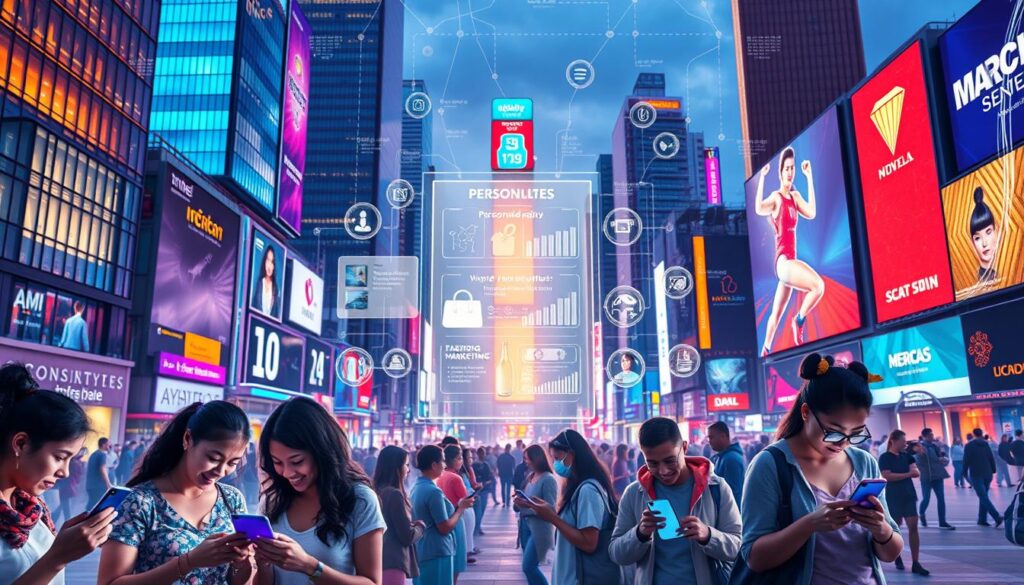If you’re into growing your marketing, you know how key personalized marketing is today. It’s all about making your marketing fit each customer or group better.
Using data-driven insights and new tech, you can make ads that really speak to your audience. This approach boosts engagement and sales.
Key Takeaways
- Understand the concept of outbound personalization and its benefits
- Learn how to implement personalized marketing strategies effectively
- Discover the importance of data-driven insights in marketing
- Explore ways to create targeted campaigns that drive results
- Elevate your marketing strategy with outbound personalization
The Power of Personalized Marketing in the Digital Age
The digital age has brought a new marketing era. Personalization is now key for brands to connect with today’s consumers. As a marketer, using personalized marketing strategies can help you reach your audience effectively.

From Mass Marketing to Individual Engagement
The move from mass marketing to personalized marketing is a big change. Now, you can use data and digital tools to make your marketing fit each person’s likes and actions. This makes the customer experience better and builds a stronger bond with your audience.
This method leads to better engagement. You can meet your customers’ specific needs and interests. This boosts the chance of them buying from you and becoming loyal to your brand.
Why Personalization Matters to Modern Consumers
Today’s consumers want a personalized experience from brands. If you don’t offer this, you might lose sales and loyalty. By understanding the value of personalization, you can make marketing that really speaks to your audience. This can increase engagement and help your business grow.
Personalization shows your customers you care about their unique needs. This makes them more likely to interact with your brand and become loyal customers.
What is Outbound Personalization? Core Concepts and Principles
In today’s competitive marketing world, outbound personalization is key. It helps businesses connect with their audience on a personal level. This strategy involves making your marketing efforts fit each customer or group, based on their unique needs.
Personalized communication can lead to deeper connections and more effective marketing.

Defining Outbound Personalization in Marketing
Outbound personalization uses data and analytics to understand customer behavior and preferences. This lets you create messages that really speak to your audience. It’s about moving away from generic messages and towards content that meets each customer’s specific needs and interests.
The Psychology Behind Personalized Customer Outreach
The power of outbound personalization comes from making customers feel seen and understood. This builds loyalty and trust. By using personalized customer outreach, you can make your interactions more engaging and meaningful. This drives long-term relationships and customer loyalty.
Building Meaningful Connections Through Tailored Communication
Tailored communication is central to outbound personalization. It lets businesses connect with their audience in a more meaningful way. By doing this, your marketing efforts are not just seen but also resonate with your target audience. This leads to better marketing results.
Outbound Personalization vs. Inbound Personalization: Strategic Differences
It’s key to know the difference between outbound and inbound personalization for a good marketing plan. As you explore the world of modern marketing, seeing these differences helps you fine-tune your strategies.
Contrasting Methodologies and Approaches
Outbound personalization means sending out messages to customers. Inbound personalization, on the other hand, focuses on making experiences for those already interacting with your brand. This big difference means you need different ways to do things.
Outbound uses data to find and talk to new customers. It aims to connect with them through messages that matter. Inbound, though, uses what customers do and say to offer them what they need.
Creating a Balanced Marketing Strategy with Both Approaches
To get the most out of your marketing, mix outbound and inbound personalization. This mix helps create a smooth experience for customers across different points of contact. For example, use outbound to draw in new customers, then inbound to keep them interested.
By using a balanced marketing strategy, you can improve your marketing and get better results. It’s all about knowing your audience and making your marketing personal to them. This way, you build a personalized marketing experience that keeps customers coming back.
Data-Driven Foundations for Effective Outbound Personalization
To make your marketing better, using data is key. It helps create experiences that feel personal. Understanding what your customers like and need is at the heart of this.
Essential Customer Data Points for Personalization Success
To succeed in personalization, you must collect and study the right customer data. This includes demographic information like age and where they live. Also, behavioral data such as what they buy and how they browse.
Knowing these details lets you send messages that really speak to your audience. For example, looking at what customers buy can show you what they like. This helps you make your marketing more effective.
Ethical Data Collection and Privacy Considerations
Collecting data is vital for personalization, but doing it right is just as important. It must be done ethically and with respect for privacy. Being open about how you use data and letting customers control it builds trust.
Having strong data protection is not just the law; it keeps customers coming back. Be clear about your data use and follow rules like GDPR.
Leveraging Analytics to Uncover Personalization Opportunities
Analytics tools are essential for finding ways to make your personalization better. They help you see how customers interact with your brand. This way, you can find chances to make their experience better.
With advanced analytics, you can guess what customers might do next. This lets you engage with them in a way that feels personal. It makes customers happier and helps your business grow.
Implementing Outbound Personalization Across Marketing Channels
As a marketer, you can make your campaigns better by using outbound personalization in many marketing channels. This way, you can make a strong marketing plan that speaks to your audience. Personalizing your messages across channels helps give customers a consistent and engaging experience.
Email Marketing Personalization Strategies and Best Practices
Email marketing is a key area for personalization. You can make subject lines, content, and offers more personal by using customer data. This makes your emails more engaging and effective.
Some good ways to personalize emails include using the recipient’s name and tailoring content based on their past actions. Sending offers that match their interests can also boost your results. These strategies can lead to better open rates and more clicks.
Direct Mail and Physical Outreach Personalization Techniques
Direct mail and physical outreach can also be personalized. By using data, you can make customized mailers that speak directly to the recipient. This makes your messages stand out and builds a stronger connection with your customers.
Social Media and Digital Advertising Personalization
Social media and digital ads are great for personalization. You can use customer data to create targeted ads that speak to your audience. Facebook and Google Ads offer tools to help you reach people with personalized messages at the right time.
To personalize on social media, know what your audience likes and tailor your content and ads. Using dynamic ad creative that changes based on viewer interests can also be effective.
Sales Outreach and Cold Calling Personalization
Personalization can also improve sales outreach and cold calling. By researching your leads and understanding their needs, you can make personalized pitches that address their specific concerns. This approach can lead to better results and stronger customer relationships.
To personalize in sales outreach, use CRM data and social media insights. This helps you connect with prospects on a personal level, building trust and credibility.
Advanced Outbound Personalization Technologies and Tools
To improve your marketing, it’s key to check out the newest in outbound personalization tech. As marketing changes, using these advanced tools is vital for keeping up and connecting with customers.
Revolutionizing Personalization – AI and machine learning have changed how we personalize. They help businesses understand customer data, spot trends, and make targeted campaigns.
AI and Machine Learning Applications for Scalable Personalization
AI and machine learning lead in outbound personalization. They help analyze big data to guess what customers might want. “AI-driven personalization can boost conversion rates by up to 20%,” a study found. These tools let you personalize more without losing relevance or impact.
Dynamic Content Generation and Automation Platforms
Dynamic content and automation platforms are key for real-time personalization. They let you adjust your messages based on what customers do and like. This makes your marketing both smart and effective.
A marketing pro said, “Dynamic content is about telling a story that speaks to each customer.” This method boosts engagement and drives sales.
Predictive Analytics for Anticipatory Customer Engagement
Predictive analytics is key for guessing what customers might want next. It looks at past data and current actions. This lets you personalize your outreach before customers even ask.
By using these advanced tools, you can make your marketing better. It will be more efficient and effective in reaching and engaging customers.
Measuring ROI and Success of Your Outbound Personalization Efforts
The success of outbound personalization depends on its ability to show real results. Measuring ROI is key. You need to track key performance indicators (KPIs) and use data to guide your strategy.
Key Performance Indicators for Personalized Campaigns
It’s important to watch open rates, click-through rates, and conversion rates. These KPIs show how well your campaigns are doing. They tell you how your audience is reacting to your efforts.
- Open rates show if people are engaging with your campaign.
- Click-through rates tell you if your content is interesting.
- Conversion rates show if your campaign is successful in getting people to take action.
A/B Testing Frameworks for Continuous Optimization
A/B testing is key for making your campaigns better. It lets you see which parts of your campaign work best. This way, you can make smart choices to boost your results.
To use A/B testing, you create different versions of your campaign. This could be different subject lines, email content, or call-to-action buttons. Then, you see how they affect your KPIs.
Attribution Models for Personalization Impact Assessment
Attribution models help figure out how personalization affects your ROI. They show how your marketing efforts, like personalization, contribute to your success. This helps you understand the impact of your personalization.
Using these tools and methods, you can improve your personalization strategy. This leads to better results and a higher marketing ROI.
Real-World Success Stories: Outbound Personalization Case Studies
Outbound personalization case studies show how marketing can grow and build loyalty. They offer insights into making marketing strategies work for each customer. This helps businesses learn from real examples.
B2B Outbound Personalization Success Stories
In B2B, companies have seen big wins with outbound personalization. For example, personalized emails and account-based marketing boost engagement and sales. HubSpot found that personalized CTAs are 42% better than generic ones.
Businesses like Salesforce use personalized outreach to connect better with customers and increase sales.
- Personalized email campaigns boost open rates and click-through rates.
- Account-based marketing targets high-value accounts more effectively.
- Tailored content improves customer engagement and loyalty.
B2C Brands Transforming Results Through Personalized Outreach
B2C brands have also seen great results with outbound personalization. Companies like Amazon and Netflix use personalized recommendations to boost sales and loyalty. A study found that personalized recommendations can increase sales by up to 30%.
“Personalization is not just a trend; it’s a fundamental shift in how businesses interact with their customers.”
— Forrester
B2C brands use data and analytics for targeted marketing. This approach not only increases sales but also builds a stronger bond with customers.
Conclusion: The Future of Outbound Personalization
Marketing is always changing, and outbound personalization will become even more key. By keeping up with new trends and tech, your marketing will stay strong and effective.
The future of outbound personalization will be shaped by AI, machine learning, and data analytics. These tools will help businesses make more targeted campaigns. As a marketer, it’s vital to keep up with personalization trends and adjust your strategy as needed.
Using data and the latest personalization tech can lead to great results. This way, you can stay ahead in a competitive market.




